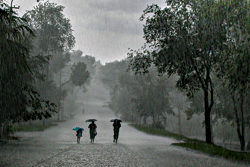Changing Rain and Snow Patterns
 As temperatures rise and the air becomes warmer, more moisture evaporates from land and water into the atmosphere. More moisture in the air generally means we can expect more rain and snow (called precipitation) and more heavy downpours. But this extra precipitation is not spread evenly around the globe, and some places might actually get less precipitation than they used to get. That's because climate change causes shifts in air and ocean currents, which can change weather patterns.
As temperatures rise and the air becomes warmer, more moisture evaporates from land and water into the atmosphere. More moisture in the air generally means we can expect more rain and snow (called precipitation) and more heavy downpours. But this extra precipitation is not spread evenly around the globe, and some places might actually get less precipitation than they used to get. That's because climate change causes shifts in air and ocean currents, which can change weather patterns.
What's happening now?

The amount of precipitation has changed in various parts of the United States since the early 20th century. Source: EPA's Climate Change Indicators (2016).

On average, the world is already getting more precipitation now than it did 100 years ago: 6 percent more in the United States and nearly 2 percent more worldwide.
The effects vary by region, though. For example, states in the Northeast are getting more precipitation than they used to get, but Hawaii is getting less.
What will happen in the future?
Precipitation is expected to increase in higher latitudes and decrease in areas closer to the Equator. The northern United States will become wetter while the South, particularly the Southwest, will become drier.
Why does it matter?
Too little or too much water can be a problem. In many places, people depend on rain and snowmelt to fill lakes and streams and provide a source of water for drinking, watering crops, and other uses. However, heavy rain can cause flooding.
Check out the major effects of changing rain and snow patterns on people and the environment: